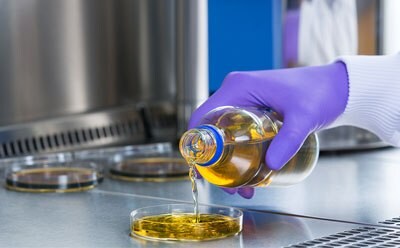Przygotowanie podłoża do hodowli drobnoustrojów

Przygotowanie podłoża do hodowli drobnoustrojów to proces mieszania składników odżywczych, środków buforujących i utrzymujących równowagę osmotyczną, a także selektywnych inhibitorów lub wskaźników w celu stworzenia agaru lub bulionu, który wspomaga wzrost i różnicowanie mikroorganizmów. Przygotowanie pożywki dla mikroorganizmów jest rutynowym zadaniem w regularnym monitorowaniu psucia się i patogennych mikroorganizmów w badaniach mikrobiologicznych.
Nagrodzone kategorie
Odkryj wysokiej jakości pożywki do hodowli drobnoustrojów. Wybierz spośród opcji odwodnionych lub gotowych do użycia, spełniających standardy branżowe i wymogi regulacyjne.
Zapoznaj się z naszą szeroką gamą surowców i suplementów pożywek do celów mikrobiologicznych. Wszystkie nasze surowce i suplementy do pożywek są bezpieczne w użyciu i zapewniają optymalną wydajność.
Zapoznaj się z certyfikowanymi mikrobiologicznymi materiałami referencyjnymi: VITROIDS™, krążki LENTICULE® firmy Supelco®. Idealne do testowania żywności, napojów i konopi indyjskich. Zamów już dziś.
Rodzaje pożywek
Podłoża do hodowli drobnoustrojów powinny zapewniać optymalne warunki wzrostu dla wszystkich lub określonych rodzajów mikroorganizmów. Dokładny skład pożywki zależy od hodowanego gatunku i celu zastosowania. pH pożywki należy dostosować w zależności od mikroorganizmów. Podłoża do hodowli drobnoustrojów są klasyfikowane na podstawie kilku parametrów, takich jak składniki chemiczne, charakter fizyczny i funkcja. Rodzaje pożywek zdefiniowane przez te parametry opisano poniżej.
Klasyfikacja pożywek do hodowli drobnoustrojów według składu chemicznego
Podłoże syntetyczne to podłoże o określonym składzie chemicznym, powszechnie stosowane do hodowli fotoautotrofów, takich jak cyjanobakterie i protisty fotosyntetyzujące. Jest szeroko stosowana w badaniach nad metabolizmem mikroorganizmów.
Podłoże złożone to podłoże zawierające nieokreślone składniki chemiczne, takie jak pepton, ekstrakt mięsny i ekstrakt drożdżowy, które spełniają wymagania żywieniowe różnych mikroorganizmów. Służy do hodowli drobnoustrojów o złożonych wymaganiach żywieniowych.
Podłoża do hodowli drobnoustrojów oparte na naturze fizycznej
Podłoże stałe wykorzystuje 1-7% agar-agar lub 10-20% żelatynę do zestalenia płynnego bulionu. Podłoże stałe jest używane do izolowania różnych drobnoustrojów od siebie, tworzenia czystych kultur, wykonywania skosów agarowych i wykonywania kłuć agarowych.
Podłoże płynne nie zawiera żadnych środków zestalających. Po zaszczepieniu i inkubacji komórki stają się widoczne w postaci niewielkiej masy lub rozmycia bulionu.
Podłoża do hodowli drobnoustrojów w oparciu o metodę przygotowania
Podłoże gotowe do użycia to stałe lub płynne podłoże dostarczane w płytkach, butelkach, probówkach lub innych pojemnikach, w postaci gotowej do użycia lub gotowej do użycia po przetopieniu i uzupełnieniu.
Pożywka przygotowana z komercyjnie odwodnionych preparatów to pożywka w postaci suchej, która wymaga ponownego uwodnienia i przetworzenia przed użyciem, w wyniku czego uzyskuje się pożywkę kompletną lub niekompletną, do której przed użyciem dodaje się suplementy.
Pożywka przygotowana z poszczególnych składników to pożywka wyprodukowana przez laboratorium mikrobiologiczne w całości z jej poszczególnych składników.
Podłoże na żądanie jest produkowane przez system, który utrzymuje wysoce skoncentrowane, sterylne podłoże hodowlane dostępne w laboratorium przez kilka dni. Poprzez rozcieńczenie sterylną wodą może on wytworzyć wymaganą ilość gotowej do użycia pożywki na żądanie, bez konieczności autoklawowania.
Przygotowanie pożywki do hodowli drobnoustrojów
Przygotowanie pożywki z odwodnionych preparatów handlowych powinno odbywać się zgodnie z instrukcjami producenta. Skład podstawowych składników, takich jak peptony, ekstrakty drożdżowe, agar, substancje buforujące i antybiotyki, jest modyfikowany w celu uzyskania konsystencji pożywki. Wymagana ilość odwodnionej pożywki lub poszczególnych składników jest rozpuszczana w wodzie destylowanej poprzez ciągłe mieszanie, a następnie podgrzewanie (jeśli to konieczne). Pożywki zawierające agar powinny być odpowiednio namoczone z odpowiednim mieszaniem przed podgrzaniem. Należy wyregulować pH, a podłoże jest dozowane do odpowiednich pojemników w celu sterylizacji za pomocą wilgotnego ciepła w autoklawie. Substancje wrażliwe na ciepło (np. białka, enzymy) są sterylizowane za pomocą filtrów membranowych.
Podłoża hodowlane muszą być przechowywane w określonych temperaturach, aby zapobiec modyfikacji składu i nie dłużej niż okres trwałości produktu. Aseptyczne przygotowanie i przechowywanie są niezbędne do ochrony pożywek przed infekcją mikrobiologiczną. Utrata wody podczas przechowywania może być zminimalizowana poprzez nieprzepuszczalne opakowanie i/lub przechowywanie w temperaturze 5 °C ± 3 °C. Degradację chemiczną, np. utlenianie lub utratę właściwości przeciwdrobnoustrojowych, można opóźnić poprzez ochronę przed światłem, ciepłem i odwodnieniem.
Odwiedź naszą wyszukiwarkę dokumentów, aby znaleźć arkusze danych, certyfikaty i dokumentację techniczną.
Powiązane artykuły
- Microbiologists focus on reproducible microbial growth, crucial for natural or engineered microorganisms, emphasizing reproducibility in cultures.
- Różne rodzaje podłoży hodowlanych, które są wykorzystywane do hodowli mikroorganizmów w laboratorium w celu kontroli jakości, są klasyfikowane według kilku kryteriów, takich jak konsystencja, skład lub selektywność.
- Microbial culture media is available in both powdered and granulated forms. This article compares the characteristics of each culture media format with regards to safety, handling and convenience.
- Adapt culture media for optimal microbial growth, considering nutrients and environmental conditions.
- Podłoża hodowlane z certyfikatem Halal zapobiegają zanieczyszczeniu składnikami niehalal, umożliwiając mikrobiologiczne testy QC bez utraty certyfikatu.
- Zobacz wszystkie (46)
Powiązane protokoły
- Międzynarodowa Organizacja Normalizacyjna (ISO) opublikowała w 2017 r. poprawione normy EN ISO 21528-1 i EN ISO 21528-2.
- Comparison of MC-Media Pad® with different convenience solution products for indicator organism testing
- Public Health England (PHE) video contains storage conditions and directions for preparing LENTICULE discs as reference materials within solid and liquid media.
- ISO updated Listeria detection standards in 2017, specifying methods for food and environmental samples.
- Nowa norma EN ISO 22964:2017 określa horyzontalną metodę wykrywania bakterii Cronobacter spp. w żywności, paszy dla zwierząt i próbkach środowiskowych.
- Zobacz wszystkie (10)
Znajdź więcej artykułów i protokołów
Jak możemy pomóc
W przypadku jakichkolwiek pytań, prosimy o przesłanie prośby o wsparcie klienta
lub rozmowę z naszym zespołem obsługi klienta:
Email [email protected]
lub zadzwoń +1 (800) 244-1173
Dodatkowe wsparcie
- Chromatogram Search
Use the Chromatogram Search to identify unknown compounds in your sample.
- Kalkulatory i aplikacje
Web Toolbox - narzędzia naukowe i zasoby dla chemii analitycznej, nauk przyrodniczych, syntezy chemicznej i materiałoznawstwa.
- Customer Support Request
Obsługa klienta, w tym pomoc przy zamówieniach, produktach, kontach i kwestiach technicznych związanych z witryną.
- FAQ
Explore our Frequently Asked Questions for answers to commonly asked questions about our products and services.
Zaloguj się lub utwórz konto, aby kontynuować.
Nie masz konta użytkownika?Dla wygody naszych klientów ta strona została przetłumaczona maszynowo. Dołożyliśmy starań, aby zapewnić dokładne tłumaczenie maszynowe. Tłumaczenie maszynowe nie jest jednak doskonałe. Jeśli tłumaczenie maszynowe nie spełnia Twoich oczekiwań, przejdź do wersji w języku angielskim.



















